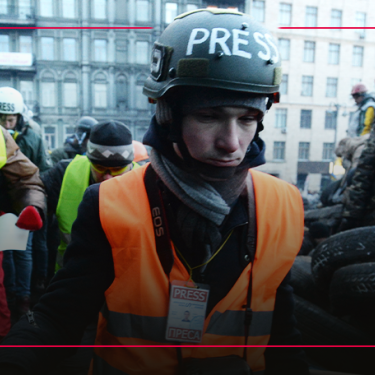Good news about Ukraine: ten years after the Euromaidan’s uprising, a more diverse and transparent media landscape

Legislative reforms, media transparency, a stronger role for independent media outlets... In a decade, the working environment for journalists and the media landscape in Ukraine have improved significantly, despite the war waged by Russia on its territory. Reporters Without Borders (RSF) takes a look at the main progress made since the start of the pro-European demonstrations on Kyiv's Independence Square in 2013.
This 21 November marks the tenth anniversary of the Euromaidan’s uprising. For four months in 2013, hundreds of thousands of demonstrators set up barricades on Independence Square in the Ukrainian capital, Kyiv, and in the rest of the country to protest against corrupt, pro-Russian elites and demand closer ties with the European Union.
The uprising toppled Viktor Yanukovych’s presidency and paved the way for major improvements in the working environment for journalists. Ukraine’s ranking in RSF’s World Press Freedom Index has gone from 126th in 2013 to 79th in 2023.
“Since Euromaidan, Ukrainian journalism, a reflection of society, has come a long way. The proliferation of independent media, legislative reforms and greater media transparency have improved the situation for press freedom. Despite the war that is putting journalism under pressure, and despite the many challenges that remain in terms of pluralism and economic viability, RSF welcomes the progress that has been made in ten years in the right to information in Ukraine.
● Many legislative reforms reinforcing press freedom and the right to information.
One of these reforms resulted in the creation of a public broadcast media group, Suspilne, in 2017 that now includes a national news website, regional websites, a TV channel and a radio station. A new media law passed in December 2022 brought Ukraine into line with European standards and increased transparency about media ownership.
● Tenfold increase in investigations into attacks on journalists
The police investigate violence against journalists more thoroughly, increasing journalists’ confidence that their complaints will be taken seriously. According to the Institute of Mass Information (IMI), RSF's partner in Ukraine, local press freedom organisations report that, since 2013, the authorities have become more transparent about ongoing cases, and provide more information about them.
● Increased media transparency
Media transparency has improved considerably in Ukraine in the past ten years, which is crucial for strengthening the public’s trust in the reliability of the news and information they see. According to an IMI survey, 68% of media are now transparent, particularly about their financial and editorial situation, compared with just 14% in 2018. Twenty-five Ukrainian media outlets recently published transparency reports in the framework of the RSF-launched Journalism Trust Initiative (JTI), which shows they are paying close attention to the reliability of the information they produce even in wartime.
● Emergence of strong independent media outlets
Thanks to their investigative reporting on corruption, politics and even international stories, around ten media outlets have established themselves as major, reliable news sources. They include the investigative website Slidstvo.info and Hromadske, a website founded in 2013 that publishes a lot of long-form journalism.
Against this backdrop of notable improvements, with a growing decline in the influence of the oligarchs on the media landscape, Ukrainian journalism is nevertheless weakened by a deteriorating security situation resulting from the war. In recent months, attempts by the government to control the media have also led to fears that the real progress made in press freedom and the right to information over the last ten years will be undermined.
